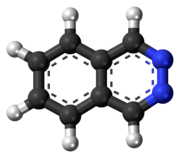 | |
 | |
| Names | |
|---|---|
| Preferred IUPAC name Phthalazine | |
| Other names
Benzo-orthodiazine 2,3-Benzodiazine Benzopyridazine | |
| Identifiers | |
| CAS Number | |
| 3D model (JSmol) | |
| ChemSpider | |
| ECHA InfoCard | 100.005.422 |
| PubChem CID | |
| UNII | |
| CompTox Dashboard (EPA) | |
InChI
| |
SMILES
| |
| Properties | |
| Chemical formula | C8H6N2 |
| Molar mass | 130.150 g·mol |
| Appearance | Pale yellow needles |
| Melting point | 90 to 91 °C (194 to 196 °F; 363 to 364 K) |
| Boiling point | 315 to 317 °C (599 to 603 °F; 588 to 590 K) (decomposition) |
| Solubility in water | Miscible |
| Acidity (pKa) | 3.39 |
| Except where otherwise noted, data are given for materials in their standard state (at 25 °C , 100 kPa).
| |
Phthalazine, also called benzo-orthodiazine or benzopyridazine, is a heterocyclic organic compound with the molecular formula C8H6N2. It is isomeric with other naphthyridines including quinoxaline, cinnoline and quinazoline.
Synthesis
Phthalazine can be obtained by the condensation of w-tetrabromorthoxylene with hydrazine, or by the reduction of chlorphthalazine with phosphorus and hydroiodic acid.
Properties
It possesses basic properties and forms addition products with alkyl iodides.
Reactions
Upon oxidation with alkaline potassium permanganate it yields pyridazine dicarboxylic acid. Zinc and hydrochloric acid decompose it with formation of orthoxylylene diamine. The keto-hydro derivative phthalazone (C8H6ON2), is obtained by condensing hydrazine with orthophthalaldehydoacid. On treatment with phosphorus oxychloride, it yields a chlorphthalazine, which with zinc and hydrochloric acid gives isoindole (C8H7N), and with tin and hydrochloric acid, phthalimidine (C8H7ON), the second nitrogen atom being eliminated as ammonia.
References
- Merck Index, 11th Edition, 7344.
- Nomenclature of Organic Chemistry : IUPAC Recommendations and Preferred Names 2013 (Blue Book). Cambridge: The Royal Society of Chemistry. 2014. p. 212. doi:10.1039/9781849733069-FP001. ISBN 978-0-85404-182-4.
- Brown, H.C., et al., in Baude, E.A. and Nachod, F.C., Determination of Organic Structures by Physical Methods, Academic Press, New York, 1955.
- ^ [REDACTED] One or more of the preceding sentences incorporates text from a publication now in the public domain: Chisholm, Hugh, ed. (1911). "Phthalazines". Encyclopædia Britannica. Vol. 21 (11th ed.). Cambridge University Press. p. 545.